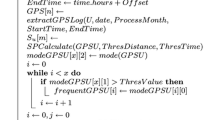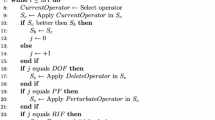Abstract
We consider the problem of determining suitable meeting times and locations for a group of participants wishing to schedule a new meeting subject to already scheduled meetings possibly held at a number of different locations. Each participant must be able to reach the new meeting location, attend for the entire duration, and reach the next meeting location on time. In particular, we give two solutions to the problem instance where each participant has two scheduled meetings separated by a free time interval. We present an O(n logn) algorithm for n participants obtained by purely geometrical arguments. Our second approach uses the concept of LP-type problems and leads to a randomized algorithm with expected running time O(n). We also consider a graph-based model where participants belong to different groups and can travel along the edges of a graph. For the meeting, only one member out of each group is required. The resulting problem can be solved using furthest color Voronoi diagrams on graphs.














Similar content being viewed by others
References
Abellanas M, Hurtado F, Icking C, Klein R, Langetepe E, Ma L, Palop B, Sacristan V (2001) The farthest color Voronoi diagram and related problems. In: Proceedings of 17th European workshop comput. geom., Berlin, 26–28 March 2001, pp 113–116
Ambite JL, Barish G, Knoblock CA, Muslea M, Oh J (2002) Getting from here to there: interactive planning and agent execution for optimized travel. In: Proc. 18th national conference on artificial intelligence. AAAI, MIT, Cambridge, pp 862–869
Aurenhammer F, Klein R (2000) Voronoi-Diagrams. In: Sack J-R, Urrutia J (eds) Handbook of computational geometry. Elsevier Science, North-Holland, Amsterdam, pp 201–290
BenHassine A, Ho T (2007) An agent-based approach to solve dynamic meeting scheduling problems with preferences. Eng Appl Artif Intell 20(6):857–873
Bentley JL, Ottmann T (1979) Algorithms for reporting and counting geometric intersections. IEEE Trans Comput C28:643–647
Chazelle B, Matoušek J (1993) On linear-time deterministic algorithms for optimization problems in fixed dimension. In: Proc. 4th ACM-SIAM sympos. discrete algorithms. ACM, SIAM, New York, pp 281–290
Chun A, Wai H, Wong RYM (2003) Optimizing agent-based meeting scheduling through preference estimation. Eng Appl Artif Intell 16(7–8):727–743
Gervais E, Liu H, Nussbaum D, Roh Y-S, Sack J-R, Yi J (2007) Intelligent map agents—a ubiquitous personalized GIS. ISPRS J Photogramm Remote Sens 62(5):347–365 (special issue on Distributed Geoinformatics)
Hornsby K, Egenhofer M (2002) Modeling moving objects over multiple granularities. Ann Math Artif Intell 36(1–2):177–194
Huda MN, Kamioka E, Yamada S (2007) An efficient and privacy-aware meeting scheduling scheme using common computational space. IEICE Trans 90-D(3):656–667
Hurtado F, Klein R, Langetepe E, Sacristán V (2004) The weighted furthest color Voronoi diagram on trees and graphs. Comput Geom Theory Appl 27:13–26
Jennings NR, Jackson AJ (1995) Agent-based meeting scheduling: a design and implementation. IEEE Electron Lett 31:350–352
Klein R, Yi J, Nussbaum D, Sack J-R (2006) How to fit in another meeting. IEEE 2nd international conference on collaborative computing (CollaborateCom 2006), Atlanta, November 2006. http://ieeexplore.ieee.org.
Klein R, Yi J, Nussbaum D, Sack J-R (2008) A meeting scheduling problem respecting time and space. In: 4th international conference on algorithmic aspects in information and management, Shanghai, June 2008
Matoušek J (1994) On geometric optimization with few violated constraints. In: Symposium on computational geometry. ACM, New York, pp 312–321
Megiddo N (1983) The weighted Euclidean 1-center problem. Math Oper Res 8:498–504
Mehlhorn K, Meiser S, Rasch R (2001) Furthest site abstract Voronoi diagrams. Int J Comput Geom Appl 11(6):583–616
Radon J (1921) Mengen konvexer Körper, die einen gemeinsamen Punkt enthalten. Math Ann 83:113–115
Rappaport D (1989) Computing the furthest site Voronoi diagram for a set of disks. In: Algorithms and data structures, workshop WADS’89, Lecture notes in computer science, vol. 382. Springer, Heidelberg, pp 57–66
Rasmussen RV, Trick MA (2006) The timetable constrained distance minimization problem. In: Lecture notes in computer science, vol. 3990. CPAIOR, Cork, 31 May—2 June 2006, pp 167–181
Rinaldi F, Serafini P (2006) Scheduling school meetings. In: PATAT, Brno, Czech Republic, Aug. 30–Sept. 1, Lecture notes in computer science, vol. 3867. Springer, Heideberg, pp 280–293
Santos P, Vaughn H (2007) Where shall we meet? Proposing optimal locations for meetings. Presented at MapISNet’07, Rio de Janeiro, 10 September 2007
Sen S (1997) Developing an automated distributed meeting scheduler. IEEE Expert Intell Syst Their Appl 12(4):41–45
Shakshuki E, Koo H-H, Benoit D, Silver D (2008) A distributed multi-agent meeting scheduler. J Comput Syst Sci 74(2):279–296
Sharir M, Welzl E (1992) A combinatorial bound for linear programming and related problems. In: Proc. 1992 symposium on theoretical aspects of computer science. Lecture notes in computer science, vol. 577. Springer, Heidelberg, pp 569–579
Wang J, Niu C, Shen R (2007) Scheduling meetings in distance learning. In: APPT, Guangzhou, China, November 22–23, Lecture notes in computer science, vol. 4847. Springer, Heidelberg, pp 580–589
Welzl E (1991) Smallest enclosing disks (balls and ellipsoids). In: Maurer H (ed) New results and new trends in computer science. Lecture notes in computer science, vol. 555. Springer, Heidelberg, pp 359–370
Acknowledgements
We would like to thank David Kirkpatrick and Emo Welzl for very helpful discussions. Also, we appreciate the valuable comments made by the referees and the editor.
Author information
Authors and Affiliations
Corresponding author
APPENDIX - Table of symbols
APPENDIX - Table of symbols
-
M: = {M 1,...,M n } the set of participants; M i the ith participant
-
\(l_{i}^{\,pre}\) previous meeting location
-
\(t_{i}^{\,pre}\) previous meeting finishing time
-
\(l_{i}^{\,sub}\) subsequent meeting location
-
\(t_{i}^{\,sub}\) subsequent meeting starting time
-
S(x) the arrival time of the last participants from their previous meetings
-
E(x) the departure time of the first participants to their subsequent meetings
-
f(x) the time interval between E(x) and S(x)
-
PRE i lower vertical cone model for M i to travel after previous meeting
-
SUB i upper vertical cone model for M i to travel before subsequent meeting
-
\(\left(\left(l_{i}^{\,pre}\right)_X,\left(l_{i}^{\,pre}\right)_Y,t_{i}^{\,pre}\right)\) apex of PRE i
-
\(\left(\left(l_{i}^{\,sub}\right)_X,\left(l_{i}^{\,sub}\right)_Y,t_{i}^{\,sub}\right)\) apex of SUB i
-
PRE intersection of PRE i ∀ 1 ≤ i ≤ n
-
SUB intersection of SUB i ∀ 1 ≤ i ≤ n
-
F intersection of PRE and SUB
-
V pre the furthest Voronoi diagram of the discs cut from PRE i at a time plane, ∀ 1 ≤ i ≤ n
-
V sub the furthest Voronoi diagram of the discs cut from SUB i at a time plane, ∀ 1 ≤ i ≤ n
-
D i a circle cut from PRE i or SUB i at a time plane
-
l′ the earliest meeting possible point
-
l′′ the latest meeting possible point
-
m′ the bottommost point of PRE
-
m′′ the topmost point of SUB
-
S′ the projection of the convex shape of PRE cut by a plane H′ onto the XY plane
-
S′′ the projection of the convex shape of SUB cut by a plane H′ onto the XY plane
-
(f,S) a function to be lexicographically maximized for the LP-type problem
-
x i a location in the XY plane
-
(x 1, S(x 1)) a point in 3-d space
-
(x 1, E(x 1)) a point in 3-d space
-
B S the line segment from (x 1, S(x 1)) to (x 2, S(x 2))
-
B E the line segment from (x 1, E(x 1)) to (x 2, E(x 2))
-
M′ subset of M
-
OPT M′ the lexicographically optimum pair (f(x),S(x)) for a meeting of all participants in M′
-
f| M′(x) the maximum duration for a meeting at location x of all participants in M′
-
X(OPT M′) the unique location where the optimum meeting is held.
Rights and permissions
About this article
Cite this article
Berger, F., Klein, R., Nussbaum, D. et al. A meeting scheduling problem respecting time and space. Geoinformatica 13, 453–481 (2009). https://doi.org/10.1007/s10707-008-0053-4
Received:
Accepted:
Published:
Issue Date:
DOI: https://doi.org/10.1007/s10707-008-0053-4




